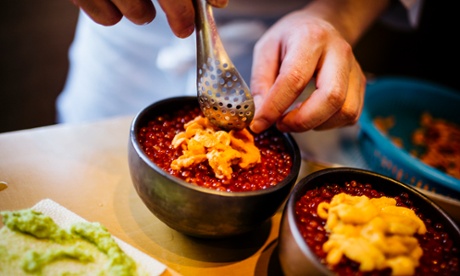
A summer swell on the Sea of Japan has curtailed the day’s fishing on Hokkaido’s remote Shakotan peninsula in the far north of the country. But if Shirikawa Koji is perturbed, he is not letting on.
The fisherman’s sunny demeanour can be explained by the precious haul lying in a small container by his feet. Flexing their sharp spines in the saltwater are his catch of sea urchins – valuable at up to ¥40,000 (£205) for 300 grammes.
This peninsula, on Hokkaido’s west coast, is known for its cool, clear waters and its profusion of tasty konbu (sea kelp), which is a key element of the sea urchin diet. As such, this area is regarded as the mother lode of Japan’s best uni, the creatures’ egg-producing organs.
I first tried this gelatinous treat in a Tokyo restaurant five years ago. Since then sweet and creamy uni has become one of the “it” ingredients of contemporary Japanese dining, used to top pasta dishes, lined up on split marrowbones and spread like butter on slabs of marbled beef.
In Hokkaido, the locals like to keep things simple. In Shatokan town, chef Kiichi Sasaki, proprietor of Fuku Zushi, serves us generous heaps of unctuous uni on firm miniature beds of rice.
Less prosaic is Otaru Tatsumi Sushi in the pretty harbour town of Otaru, a few miles to the east. Its uni-don (sea urchin rice bowl) with ikura (salmon eggs) is decadent perfection. Even better, if that’s possible, is the uni chawanmushi (steamed egg custard) where the savoury base is topped with uni, a cherry tomato and fresh shrimp.
Uni is known to be an aphrodisiac. And eating it direct from the source is never less than arousing.

